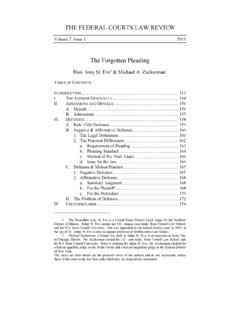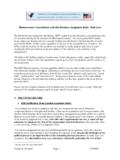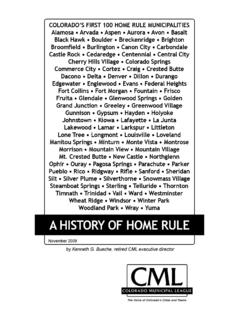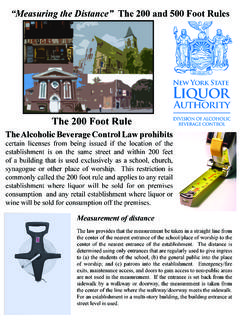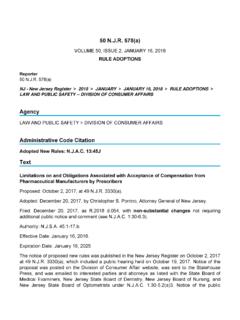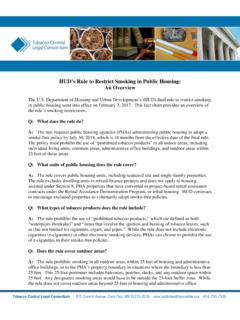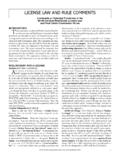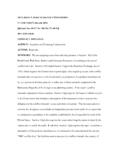Transcription of The Implications of Rule 26(g) on the Use of Technology ...
1 THE FEDERAL COURTS LAW review . Volume 7, Issue 1 2013. The Implications of Rule 26(g) on the Use of Technology - assisted review Karl Schieneman 1 and Thomas C. Gricks III 2. FOREWORD. The past few years have introduced a new player into the lexicon of ESI discovery Technology assisted review , or TAR, aka predictive coding. Touted by some as the antidote for disproportionally expensive discovery of digital information, and condemned by others as an expensive, jargon-infested ruse to avoid legitimate production obligations, it is hard for lawyers, clients and judges to sort through the positive and negative hype, and reach a principled decision whether TAR is the long awaited solution, or just another exotic fad.
2 Enter Karl Schieneman and Tom Gricks, two lawyers possessed of a scientific and mathematical background and a talent for describing technical and statistical information in a way that generalists readily can understand, with a primer that is essential to understanding the proper framework to use in evaluating whether and how to employ TAR, or evaluate the appropriateness of its use by an adversary. This article accomplishes what has been sorely needed a straightforward explanation that captures the governing procedural and substantive law, as well as sets out the essential technical and statistical concepts that will permit even computer shy lawyers and judges to understand enough to make the right choices.
3 Central to the paper is the primacy of Fed. R. Civ. P. 26(g)'s discovery certification obligations, grounded in the doctrine of proportionality required by Rule 26(b)(2)(C), and the importance of cooperation with opposing counsel, and transparency in the process used to collect and analyze the data set using TAR, to select the information to be produced in response to a Rule 34 request. The article fully explains the key phases of evaluating the proper way to use TAR: (1) collection (which embraces the concepts of recall, precision, prevalence/richness, and the statistical 1. University of Massachusetts, University of Pittsburgh, Carnegie Mellon University.)
4 President of review Less, LLC. 2. Chemical Engineering, Carnegie-Mellon University, Duquesne University School of Law. Partner, Litigation Services, Schnader, Harrison, Segal & Lewis. 240 FEDERAL COURTS LAW review [Vol. 7. sampling concepts of confidence level and confidence interval); (2). disclosure to opposing counsel and the court the manner in which the documents have been collected, reviewed and produced; (3) the training of the TAR tool, through either judgmental or random selection of the training/seed set; (4) stabilization (the process of determining what levels of recall and precision are required to comply with the certification requirements of Rule 26(g), and entails considering the relative effectiveness of using TAR as opposed to the available alternatives.]
5 Principally manual review or keyword searches) and , finally, (5) validation through statistical sampling that the production using TAR meets the mandates of Rule 26(g) that counsel undertake a reasonable inquiry before certifying the responsiveness of the production to opposing counsel. This article is destined to be read and re-read by conscientious lawyers and judges as they strive to understand the promise, and avoid the pitfalls, of using TAR in ESI discovery. For that we can all be grateful. Paul W. Grimm 3. ABSTRACT. Technology assisted review has become common in cases where the collection of electronically stored information yields large quantities of potentially discoverable information.
6 Rule 26(g) of the Federal rules of Civil Procedure imposes unique obligations in this situation for counsel beginning with the reality that not all potentially relevant documents will be produced. The authors explain the nature of Technology assisted review and then apply the commands of Rule 26(g) to each phase of this review including collecting the data so that the search is truly reasonable and proportionate, disclosures to opposing counsel of methodology, creating the seed set that will guide the software's collection of the relevant data and ascertaining whether the final production will meet the recognized standards of precision and recall and similar test of validation.
7 The authors insist that counsel must know how each step of this complicated process will impact the ultimate production so counsel will be able to meet the Rule 26(g) standards without fear of being sanctioned. 3. University of California, Davis, University of New Mexico School of Law, United States District Court Judge for the District of Maryland. 2013] The Implications of Rule 26(g) 241. TABLE OF CONTENTS. I. THE LEGAL 243. II. APPLICATION TO Technology - assisted review .. 248. A. Collection .. 249. B. Disclosure .. 254. C. 259. D. Stabilization .. 263. E. 269. III. CONCLUSION .. 273. Slightly more than five years ago, Professor Richard L.
8 Marcus 4. anticipated the prominence of Federal Rule of Civil Procedure 26(g) in managing and controlling the conduct of attorneys in the burgeoning area of electronic discovery. 5 In his Keynote Address given at The University of Baltimore Law review Symposium on March 13, 2008, Professor Marcus observed: 6. For me, having spent much of the last decade focused on e-discovery, it is interesting to consider how differently we might look at e-discovery in another decade. The rate of change is likely to abate somewhat, but given how different things are now from how they were a decade ago it seems dubious to expect that things will remain the same.
9 So I'm not going to try to make predictions. Rather, I have some observations about how things may evolve and some questions about whether the fears of the past become the reality of the future. **. (4) There may be a new or enlarged role for Rule 26(g). Rule 26(g) was added in 1983, at the same time that Rule 11 was substantially revised to strengthen its provisions. At the time, it was expected (perhaps hoped). that Rule 26(g) would be just as important as Rule 11. Needless to say, that did not happen. Amended Rule 11 mushroomed into the most prominent rule of its day, eventually being narrowed in 1993 to contain its effects. Rule 26(g) slipped from view, and had minimal effect.
10 It is possible that e-Discovery will breathe new life into Rule 26(g). The 4. Horace O. Coil ( 57) Chair in Litigation Distinguished Professor of Law, University of California, Hastings College of Law, San Francisco. 5. Rule 26(g) embodies counsel's obligation to certify discovery responses, including responses to requests for production of documents and ESI, upon a reasonable inquiry. FED. R. CIV. P. 26(g)(1). 6. Richard L. Marcus, E-Discovery Beyond the Federal rules , 37 U. BALT. L. REV. 321, 344, 346 (2007-2008) (internal citations omitted). 242 FEDERAL COURTS LAW review [Vol. 7. extensive responsibilities of counsel in regard to consultations about e- discovery arrangements call for counsel to make representations to the other side, and sometimes to the court, about what can be done and when it can be done.]




